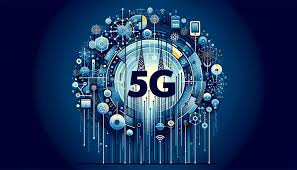The Rise of 5G Technology and Its Impact on the Future of Connectivity

Introduction
5G technology, the fifth generation of mobile network technology, is set to revolutionize how we connect, communicate, and interact with the digital world. While 4G LTE brought faster internet speeds and enhanced mobile experiences, 5G is poised to offer even more significant advancements. With its potential for ultra-fast speeds, low latency, and massive connectivity, 5G promises to impact a variety of industries, from telecommunications to healthcare, autonomous vehicles, and beyond. This article explores the rise of 5G technology, its key features, its potential applications, and the challenges it faces as it continues to roll out globally.
1. What Is 5G Technology?
- Definition and Key Features
- 5G is the latest iteration of mobile network technology, offering higher speeds, lower latency, and the ability to support a massive number of devices simultaneously. It is designed to provide faster data transmission rates, improved reliability, and increased connectivity for the growing number of connected devices.
- The key features of 5G include ultra-fast download and upload speeds, extremely low latency (which refers to the time it takes for data to travel between devices), and the ability to connect a vast number of devices simultaneously without experiencing network congestion.
- How 5G Works
- 5G operates on higher frequency radio bands compared to previous generations, which allows it to transmit more data at higher speeds. The technology uses a combination of millimeter waves, sub-6 GHz frequencies, and small cell networks to achieve its faster speeds and lower latency.
- The small cell infrastructure allows for greater density and coverage, which is essential for ensuring 5G performance in urban environments. Additionally, 5G networks use advanced technologies such as beamforming and massive MIMO (multiple input, multiple output) to enhance signal strength and coverage.
2. The Benefits of 5G Technology
- Blazing Fast Speeds and Enhanced User Experience
- One of the most significant benefits of 5G technology is its ability to provide ultra-fast internet speeds, far surpassing the speeds of 4G networks. With speeds of up to 10 Gbps, 5G allows users to download large files, stream high-definition video, and play online games with minimal buffering or lag.
- This enhanced speed and performance are expected to transform a variety of industries, from entertainment and gaming to virtual reality (VR) and augmented reality (AR), providing users with a smoother, more immersive experience.
- Low Latency and Real-Time Communication
- 5G technology promises to deliver ultra-low latency, with response times as low as 1 millisecond (ms), compared to the 30-50 ms typical of 4G networks. This reduction in latency is crucial for applications that require real-time communication and instant responses, such as remote surgery, autonomous vehicles, and industrial automation.
- With low latency, 5G can enable applications such as virtual and augmented reality to work seamlessly, allowing for real-time interactions in virtual environments, which could transform industries such as entertainment, gaming, and education.
- Massive Device Connectivity for IoT
- 5G’s ability to support a massive number of devices is a key benefit, particularly as the Internet of Things (IoT) continues to grow. IoT refers to the network of connected devices, such as smart home devices, wearables, and sensors, that communicate with each other and exchange data.
- With 5G, billions of IoT devices can be connected simultaneously without causing network congestion, allowing for smarter cities, more efficient industries, and improved quality of life. For example, 5G will enable the real-time monitoring of traffic, pollution, and public safety in urban areas, helping cities become more efficient and sustainable.
3. Potential Applications of 5G Technology
- Autonomous Vehicles
- One of the most exciting applications of 5G technology is in the development of autonomous vehicles. Self-driving cars require real-time communication between vehicles, infrastructure, and other devices to make split-second decisions.
- 5G’s low latency and high-speed capabilities make it an ideal solution for the safe and efficient operation of autonomous vehicles. By allowing vehicles to communicate with each other and with traffic signals or road sensors, 5G can help improve road safety, reduce traffic congestion, and make autonomous driving a reality.
- Healthcare: Remote Surgery and Telemedicine
- 5G’s ultra-low latency and high-speed connectivity will transform healthcare by enabling real-time remote consultations, diagnostics, and even remote surgeries. Surgeons could perform surgeries from miles away, thanks to the real-time communication enabled by 5G networks.
- 5G will also enable telemedicine to reach more people in underserved areas, improving access to healthcare and reducing wait times. With 5G, doctors can provide more accurate remote consultations using high-quality video and real-time patient data transmission.
- Smart Cities and Industrial Automation
- 5G will play a critical role in the development of smart cities by enabling the seamless connection of devices and infrastructure. From traffic management systems to energy grids and public safety networks, 5G will allow cities to function more efficiently and sustainably.
- In industrial settings, 5G will enable automation and remote monitoring of production lines, warehouses, and supply chains. With real-time data transmission, businesses can optimize processes, reduce downtime, and improve operational efficiency.
- Enhanced Mobile Gaming and Entertainment
- The gaming industry will also benefit from 5G’s high-speed and low-latency capabilities. Cloud gaming, which allows users to stream games instead of downloading them, will become more popular with 5G, as it will offer smooth, high-quality gaming experiences without lag or buffering.
- Additionally, 5G will support the growth of augmented and virtual reality applications, enabling immersive experiences in entertainment, education, and training.
4. The Challenges of 5G Rollout
- Infrastructure and Deployment Costs
- The rollout of 5G requires significant investment in infrastructure, including the installation of small cell towers, fiber-optic networks, and upgrading existing network equipment. This is a costly process, and many regions, particularly rural or underserved areas, may face delays in the deployment of 5G networks.
- Governments, telecom companies, and private sector players will need to work together to ensure that 5G infrastructure is deployed efficiently and equitably, so that all regions can benefit from this transformative technology.
- Spectrum Availability and Interference
- 5G networks require access to high-frequency radio spectrum bands, which are a limited resource. Allocating and managing these spectrum bands is a complex process, and interference between different networks and devices could be a challenge.
- Ensuring that spectrum is used efficiently and fairly will be crucial to the successful rollout of 5G. Regulatory bodies will need to work closely with telecom companies to manage spectrum allocation and prevent interference that could degrade network performance.
- Security and Privacy Concerns
- As 5G technology enables more devices to connect to the internet, security and privacy concerns become even more critical. The massive increase in the number of connected devices increases the potential attack surface for hackers and cybercriminals.
- Protecting sensitive data, ensuring secure communication between devices, and preventing cyberattacks will be essential for the widespread adoption of 5G. Telecom companies, governments, and cybersecurity experts must collaborate to create robust security protocols for 5G networks.
5. The Future of 5G Technology
- 6G and Beyond
- While 5G is still in the process of being fully deployed, research into the next generation of wireless technology, 6G, is already underway. 6G is expected to offer even faster speeds, lower latency, and more advanced capabilities, such as enhanced AI integration and holographic communication.
- 6G could enable innovations such as fully autonomous cities, more immersive augmented and virtual reality experiences, and even brain-machine interfaces. However, 6G is still a long way from being realized, and much work remains to be done to make it a reality.
- The Impact of 5G on the Global Economy
- 5G is expected to have a significant economic impact, with analysts predicting that the global 5G economy could be worth trillions of dollars by the end of the decade. The technology will drive new business models, create jobs, and boost productivity across various industries.
- As 5G continues to roll out, it will foster innovation in fields like AI, robotics, IoT, and big data, creating new opportunities for businesses and entrepreneurs worldwide.
6. Conclusion
5G technology represents a major leap forward in the way we connect to the internet and communicate with each other. With its fast speeds, low latency, and capacity to support massive connectivity, 5G promises to revolutionize various industries, from healthcare and transportation to entertainment and smart cities. While the rollout of 5G faces challenges such as infrastructure costs, spectrum management, and security concerns, its potential to transform the global economy and improve the quality of life is immense. As 5G becomes more widely available, it will lay the foundation for a more connected, efficient, and sustainable future.





